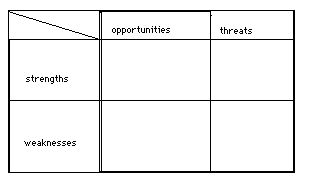
In 1985 the Coca Cola company decided to enter the market with a more diversified product range, Cherry Coke, Low Calory, etc. and terminate 'old' Coke. The main idea was to increase the rather stagnant market share of Coke. Upon the introduction of these new cokes, the market reacted in a much different way from what had been expected. Shopkeepers objected to the large shelf space required, regular coke drinkers objected to the new drinks and even started campaigns to get old coke back, and ... the market share fell drastically.
What was considered to be an opportunity proved a threat. The situation had apparently been clearly defined: the opportunities were in diversification, but dropping the regular coke proved to be a severe threat. So the old drink was reintroduced under the name 'Classic Coke' and everybody was happy (except Pepsi of course). The market share increased and became bigger than before. When the CEO was asked if this had been done on purpose, his reaction was: "I wish this were so, but we never had expected this to happen."
The SWOT diagram is a tool to come to grips with the existing situation, it creates awareness and is a good model to become aware of how different people assess and see different aspects.
Every strength and weakness is given a place thus making it clear whether it is seen as an opportunity or threat. Success, for instance, can mean a bigger threat than some people would care to acknowledge. Of course the picture obtained is only a picture of a particular moment and it may not be forgotten that "one can step in the same river only once, as the water continually changes." Situations and conditions may change and a situation which once held certain problems may no longer do so, however, one should be aware.
When filling in such a diagram it is sensible not to 'discuss' the different views of the participants, but rate them as plus or minus points. When a certain aspect is assessed in different manners it is interesting to compare the views according to the taxonomy (see there) given further on. Only when there is the discipline to really listen to other viewpoints will objective reality be approached. For reality never changes because we may disagree about it.
It also helps us to clearly distinguish between problems and opportunities/threats. For when dealing with problems we look for a solution or a way to deal with it. With an opportunity we look for benefits. With a problem we know where we want to end up. With an opportunity we do not know exactly where we want to go until we have found it. And although much stress is generally put on problem-solving, it is good to remember that every solution creates at least 2 new problems. In opportunity thinking this is different. It implies diverging and creating alternative courses of action.
The swot-diagram is a manner in which the information or data are modelled in a way intelligible to others. In formulating the strengths and weaknesses we are communicating and communication is only possible about things seen by either party. It means formulating questions, so instead of "I don't agree" it becomes "Why do you see it like that?" and "Why do I see it differently?".
Modelling information does not mean modelling the reality, it means making it concrete.
So it was with the Dutchman who visited Kenya. When he came back he explained how he had seen these interesting 'dangerous'. One had a large tail in front and a smaller one at the back and another had such a long neck that it ate out of the tops of trees. When told that these animals must surely have been elephants and giraffes, he emphatically stated that they were all 'dangerous'. Upon entering the wild life resort he had seen a large board saying: "All these animals are dangerous". So for him all animals were 'dangerous' albeit that this particular species comprised an enormous variety of forms.
This is the difficulty in communication, being aware of what we are taking about.
In his book The End Of Nature, Bill McKibben models the information about exhaust fumes as follows: 'A car discharges into the air its own weight of carbon for every 10 thousand miles you put on the clock.'
The carbon in the form of carbon dioxide accumulates in the atmosphere and absorbs infrared radiation from the sun. The heating that results is called the greenhouse effect, and that it happens is beyond dispute. There is room for argument about its magnitude and the consequences that it will have on man's future on earth, but that we have engendered massive disturbances in our environment cannot be doubted.
Yet arguments often remain vague and abstract. Therefore modelling the information in a concrete manner makes people realize what is actually happening, what their actions mean.